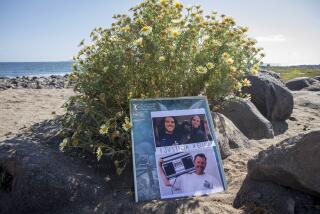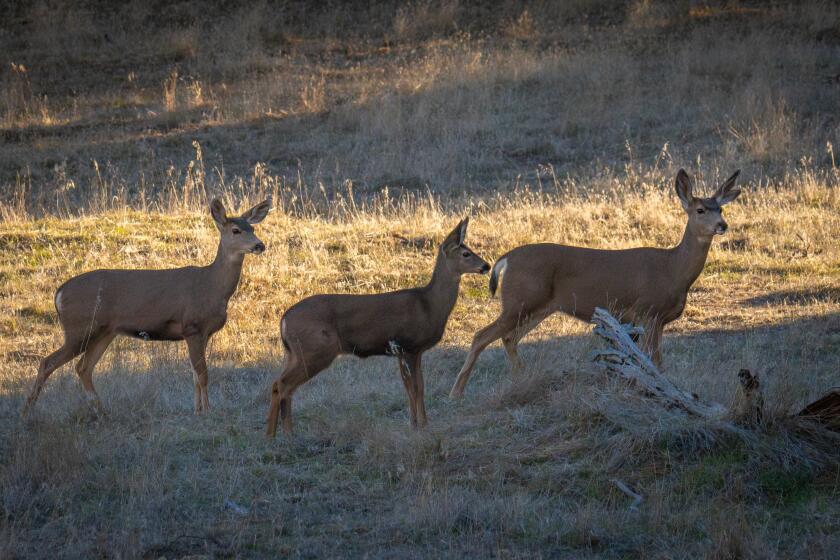Far from Iditarod, canines answer call of the wild
Thousands of miles from the Alaskan wilderness, a pair of huskies charge down a dusty path with their master in tow.
There is no sled under the feet of Rancy Reyes. Instead, his hounds work up a lather pulling his two-wheeled scooter through the brush of a Southern California park as he shouts commands that are as foreign in this sunbaked part of the world as snowflakes.
In a city better known for its high-end indoor mall than high-energy outdoor activities, “urban mushing” has taken hold. People are coming from more than two hours away to take part.
“I know plenty of Californians and nothing surprises me anymore,” said Greg Sellentin, publisher of Alaska-based Mushing, the magazine of dog-powered adventure.
Though much has been altered in its warm-weather translation, urban mushing -- or dog scootering -- is gaining popularity in snow-free parts of the country, particularly in California where dog lovers are always on the hunt for the latest canine trend.
As specialized dog bakeries, day-care centers and strollers increasingly humanize dogs, fans say urban mushing is a call to the animals’ wild roots.
“They want to start running and hunting,” said urban musher Rob Fuechtenicht. “When you hook them to the scooter, you’re riding behind them and they’re in this doggy nirvana kind of stage.”
Members of the national scootering group Dogs Across America say they’ve noticed a steady increase in membership since the organization was launched in 2005. The numbers have shot up, particularly in Texas, Washington and California, which has one of the country’s fastest-growing groups of urban mushers.
A recent outing of the Southern California Working Snow Dogs included huskies, malamutes, Dobermans and a Dalmatian -- many of which had never put paw to snow.
Other scootering groups boast photos of more unexpected breeds, including standard poodles.
The Southern California group, which started in 2005, has about 240 members, some 50 of whom show up on most weekends to traverse the winding dirt trails at Fairview Park.
Yelping, restless dogs strapped into harnesses and leashes are tethered to a non-motorized scooter just below the handlebars. The owner stands on a platform, often in shorts and T-shirt -- no need to bundle up.
The scooters, which cost between $200 and $700, are equipped with brakes and knobby tires that ride over rocks and potholes more like a mountain bike than a sled over snow. Other variations of mushing include skijoring, where dogs pull a skier, and canicross, where dogs pull a cross-country runner.
Alaskans have long hooked their dogs up to bikes during the off-season to keep them active.
For the dogs’ owners, scootering is a chance to bond with their pets and tap into the urban trails of the Lower 48.
For some of the dogs, however, getting in touch with their primal side after years of dozing on the couch can be an adjustment.
Barbara Yates had to give her dog Luke an anti-inflammatory after his initial run.
“I took him to the doctor, who said, ‘Oh my God, you’ve overworked him,’ ” she recalled.
Many people ride Diggler Scooters, made by a company that fell into the urban mushing business by accident. Fuechtenicht, the owner, said he started getting calls in 2003 from people asking about hooking up their dogs to his scooters.
“I thought these people were crazy,” he said. “It was the furthest thing from my mind. Who would’ve thought?”
Fuechtenicht, a mushing convert, has created several models of dog scooters. Last year, he sold about 250 of the contraptions. Sales this year are approaching 600, he said.
It takes about one outing for a dog paired with an experienced musher to get the hang of pulling. Learning to stay on course can take a little longer. Some pairs will go in opposite directions, chase after rabbits or stop altogether to sniff the air. There’s even an occasional collision.
“It does happen,” said Reyes, whose dogs Niko and Lyka have been known to start wrestling in the middle of a run. “They’re like the comic relief of the group. I should instill more discipline.”
Reyes, who started the Costa Mesa group, has been teaching his huskies the official mushing commands: “gee” for right and “haw” for left; “easy” to slow down; and “on-by” to pass. The dogs occasionally ignore the commands, which has earned them some unsavory nicknames.
Despite the increasing popularity of mushing, Reyes and others say they still get stares and teasing.
A group of women walking their dogs on leashes one recent Saturday stopped to watch the working dogs take a water break. Lisa Walters shook her head when asked if she would ever strap up her two dogs -- a tiny Chihuahua and a bigger brown mutt -- to a scooter.
“First of all, you’d have to train me,” she said. “And I’m not willing to do it.”
One musher was stopped recently in a public park by a ranger who told her that scooters, like skateboards, were banned.
Others say they endure quips about practicing for the Iditarod, missing the snow or even abusing their dogs. The most common taunt: “Mush!”
“Nobody ever uses the word ‘mush,’ ” Reyes said. “Not even the actual mushers.”
More to Read
Start your day right
Sign up for Essential California for news, features and recommendations from the L.A. Times and beyond in your inbox six days a week.
You may occasionally receive promotional content from the Los Angeles Times.






